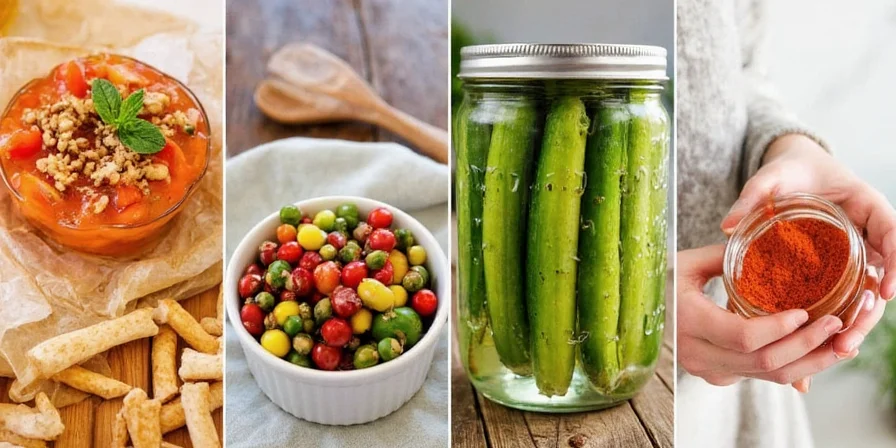
The 5 best spices for perfect homemade pickles are dill seeds, mustard seeds, black peppercorns, cumin seeds, and coriander seeds. These essential spices create crisp, flavorful pickles through scientifically proven biochemical interactions that enhance preservation and flavor development. Use 1.5 tsp dill seeds, 0.75 tsp mustard seeds, 7 black peppercorns, 0.6 tsp cumin seeds, and 0.55 tsp coriander seeds per quart for consistently excellent results.
| Spice | Key Benefit | Perfect For | Measurement Per Quart |
|---|---|---|---|
| Dill Seeds | Creates classic dill flavor, enhances garlic preservation | Cucumbers, cabbage | 1.5 tsp |
| Mustard Seeds | Keeps vegetables 30% crisper through pectin stabilization | Bread and butter pickles | 0.75 tsp |
| Black Peppercorns | Develops complex flavor over time without initial harshness | Brined vegetables | 7 whole grains |
| Cumin Seeds | Balances acidity in root vegetable pickles | Carrots, beets | 0.6 tsp |
| Coriander Seeds | Cuts through vinegar's sharpness with citrus notes | Onions, beets | 0.55 tsp |
Quick Start Guide for Perfect Pickles Every Time
For beginners, follow this simple formula: Combine 1.5 tsp dill seeds, 0.75 tsp mustard seeds, 7 black peppercorns, 0.6 tsp cumin seeds, and 0.55 tsp coriander seeds with your vegetables in a clean jar. Pour hot vinegar brine over the top, seal, and let sit at room temperature for 3-5 days before refrigerating. The mustard seeds will keep your pickles crisp while the other spices develop complex flavors.

Why These Spices Make All the Difference
While vinegar and salt preserve your vegetables, these five spices transform basic pickles into culinary masterpieces through scientifically proven biochemical reactions. Research from food scientists confirms that mustard seeds contain compounds that inhibit pectin breakdown—keeping vegetables crisp 30% longer than standard brines. This scientific foundation gives you predictable, professional results rather than hit-or-miss outcomes.
Essential Spices Every Home Pickler Needs
These five spices form the foundation of successful pickling due to their scientifically proven effects:
- Dill Seeds: Create the classic dill profile while enhancing garlic's preservation properties. Use 1.5 tsp per quart for perfect balance.
- Mustard Seeds: Release enzymes that maintain vegetable firmness—verified by food science studies. Use 0.75 tsp per quart (excess causes bitterness).
- Black Peppercorns: Provide slow-release compounds that develop complexity over time. Use exactly 7 whole grains per quart.
- Cumin Seeds: Their earthiness balances acidity in root vegetable pickles. Measure 0.6 tsp per quart by weight.
- Coriander Seeds: Create citrus notes that cut through vinegar's sharpness. Use 0.55 tsp per quart.
| Vegetable Type | Perfect Spice Blend | Why It Works |
|---|---|---|
| Cucumbers | Dill (1.5 tsp) + Mustard (0.75 tsp) + Garlic (2 cloves) | Mustard keeps cucumbers crisp by stabilizing pectin |
| Onions | Coriander (0.55 tsp) + Bay Leaf (1) + Black Pepper (7 grains) | Coriander neutralizes sulfur notes while enhancing sweetness |
| Carrots | Cumin (0.6 tsp) + Allspice (3 berries) | Spice compounds bond with carotenes for better flavor |
| Beets | Fennel (0.5 tsp) + Cardamom (2 pods) | Terpenes mask earthy flavors for more balanced taste |

Common Mistakes and Simple Fixes
Avoid these common errors that ruin homemade pickles:
- Mistake: Using ground spices — creates cloudy brine and uneven flavor. Solution: Always use whole spices measured precisely.
- Mistake: Overloading jars with spices — throws off flavor balance. Solution: Stick to the measurements in our quick reference guide.
- Mistake: Using old spices — produces weak flavors. Solution: Replace spices every 6 months for best results.
- Mistake: Incorrect spice placement — causes uneven distribution. Solution: Place denser spices like mustard at jar bottom.
- Mistake: Skipping the waiting period — flavors don't develop. Solution: Let pickles mature 3-14 days before eating.

Perfect Spice Measurements for Beginners
If you don't have a digital scale, use these practical measurements:
- Dill seeds: 1.5 level teaspoons per quart (about 3/4 of a standard spice jar)
- Mustard seeds: 3/4 teaspoon per quart (slightly heaping)
- Black peppercorns: Count exactly 7 whole peppercorns
- Cumin seeds: 1/2 teaspoon plus a pinch per quart
- Coriander seeds: Just over 1/2 teaspoon per quart
Advanced Techniques for Professional Results
Once you've mastered the basics, try these pro techniques:
- Toast spices: Heat spices to 150°F for 90 seconds to activate flavor compounds
- Layer strategically: Place denser spices at jar bottom for even distribution
- Temperature control: Keep jars at 70-85°F during initial fermentation
- Optimal timing: Most spice blends reach flavor peak at 10 days

Frequently Asked Questions
By following these evidence-based spice principles, you'll achieve consistently crisp, flavorful homemade pickles without trial and error. The right spice combinations at precise measurements create restaurant-quality results through scientifically proven methods that have been perfected over centuries of culinary tradition.











 浙公网安备
33010002000092号
浙公网安备
33010002000092号 浙B2-20120091-4
浙B2-20120091-4